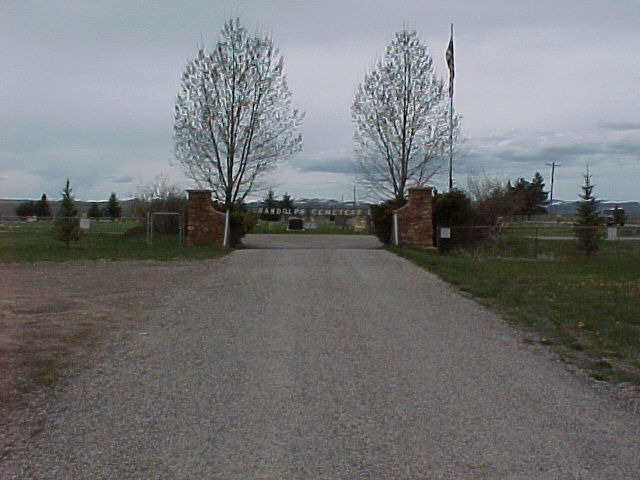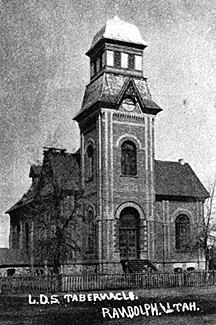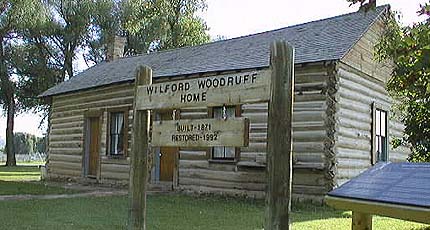Randolph
Rich County, Utah

The cemetery in Randolph, where John Alexander Cameron is buried.

The LDS Tabernacle in Randolph

Wilford Woodruff home in Randolph
Randolph
Rich County, Utah

The cemetery in Randolph, where John Alexander Cameron is buried.

The LDS Tabernacle in Randolph

Wilford Woodruff home in Randolph
From www.utahreach.usu.edu: "Randolph was settled in 1870. The first twelve men under the leadership of Randolph Stewart arrived from St. Charles, Idaho, at the present site of Randolph on March 14, 1870. During the spring and summer other settlers arrived from Salt Lake City. On Dec. 1, William Tyson arrived with a small flock of sheep. After establishing camp, the townsite was laid out and some crops planted. Many of the men returned to their homes for their families. About twenty homes were built the first summer.
The first public building was an 18 by 24 foot log building with a shingle roof. It served as an amusement hall, school house, and place of worship. Occasional winters with heavy snow caused the early settlers many hardships. Many Indians visited and lived in the area, but were on friendly terms with the settlers.
During the early years of settlement, fish, sage and prairie chicken, ducks and geese, deer, elk, mountain sheep, and antelope were in abundance. When the sheep industry became popular, the antelope numbers were reduced, but they remain common in the area. Randolph is the center of extensive cattle and sheep ranching. The Bear River Valley from the Wyoming border on the southeast extends north for miles, is about 8 miles wide and is almost exclusively cattle and sheep ranching.
Rich County takes its name from Mormon colonizer Charles C. Rich, who was called by Brigham Young to lead colonies and make settlements in this area. The first settlement's in what is now Rich County resulted from previous settlements made in the Bear Lake Valley in Idaho. Carles C. Rich had led a colony from Cache County into the Bear Lake Valley in 1863. In the fall of 1864 settlers who had spent the previous winter in Paris and surrounding communities in the Bear Lake Valley moved southward into what is now Rich County, Utah.
In 1870, a gathering of Indians (estimated at 3,000, camped on the south shore of Bear Lake causing settlers a great deal of concern and trouble; however, after a meeting of the settlers and chiefs, among them Chief Washakie, an agreement was effected and the Indians moved to Wind River, Wyoming.
Legend of the Bear Lake Monster...
Indians mysteriously told of a denizen that lived in the blue depths of Bear Lake long ago... it came out to capture and carry away many of their tribes who were swimming. They claimed the dreadful animal was serpent-like and horse-headed; that it had a length of 75 feet. Its body was like that of a crocodile or dragon, and it could spout water upwards from its mouth.
As white settlers came to the valley, many of them reported seeing the water devil. Some were too excited to describe its appearance, but others said it was dark in color resembling a log swishing through the waters. Always they remarked about its likeness to a dragon with bunches for ears from which water spurted. One account was so explicit, the viewers claimed they first heard and then saw a peculiar motion or wave in the waters, then a large nine-foot monster partly emerge then scoot along as fast as a locomotive. It was followed by a forty-foot speeder and several small ones~ all similarly shaped. The waves that rolled up in front and on each side of the heads were at least three feet high. As the animals submerged again, they left a wavy serpentine motion on the water surface.
Scientific research has been made. It concludes that the monster may
have been an actual descendant of some pterodactyl, ichthyosaur, or dinosaur
of past geological ages. Others say it is a probably descendant of a long-necked
race of mesozoic sea lizards which survived in ancient Lake Bonneville
and which migrated to Bear Lake, possibly when the salinity of the water
at Lake Bonneville got too high for its viperous taster. Realizing this
lake was once a part of Lake Bonneville or a great glacial lake that once
covered this Great Basin, we are told in "HEART THROBS OF THE WEST", it
is not unlikely some remnant of sea life remained in the region when pioneers
first arrived."